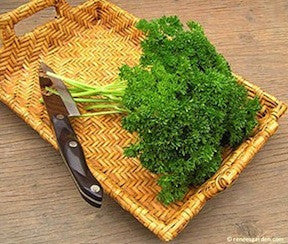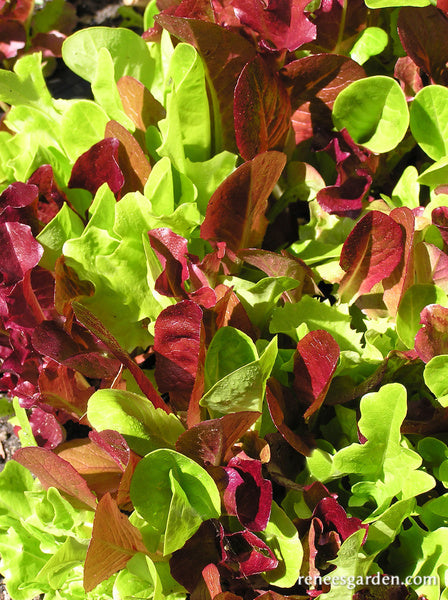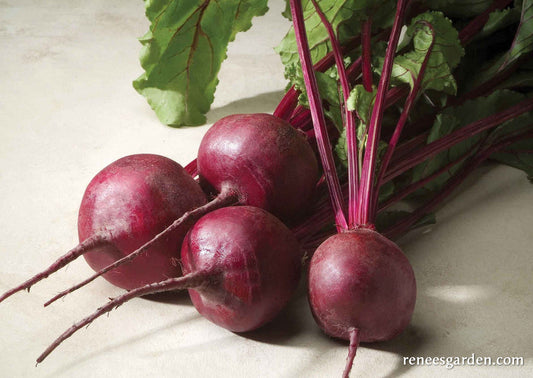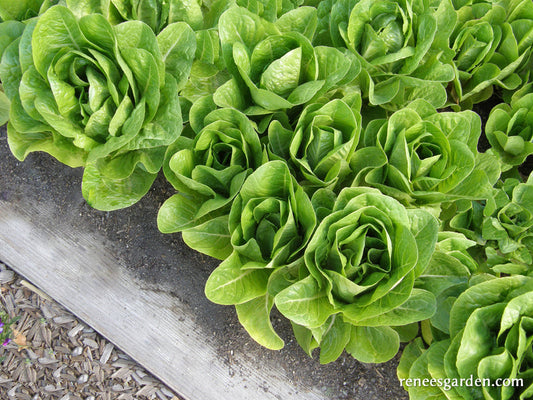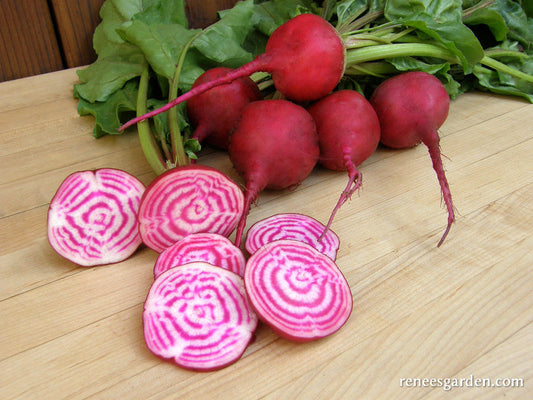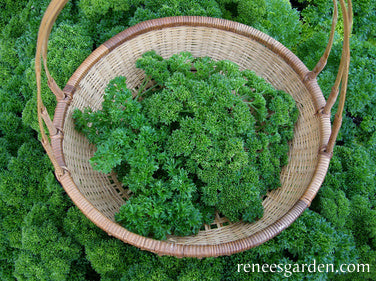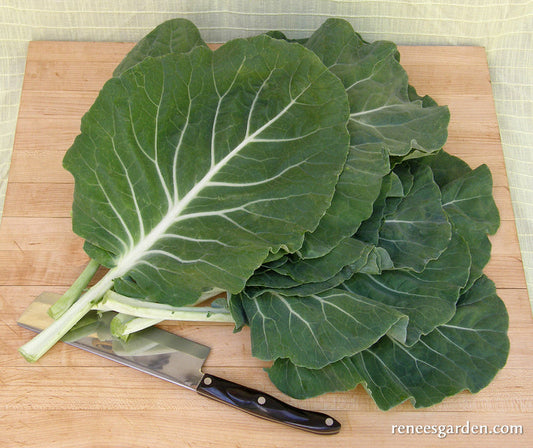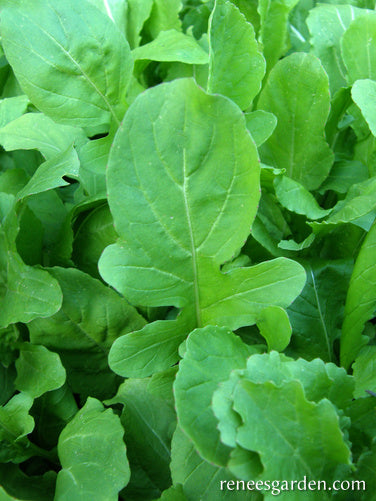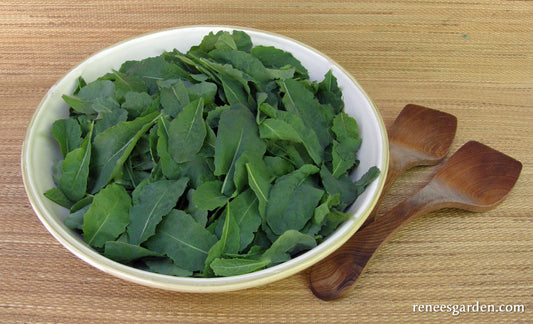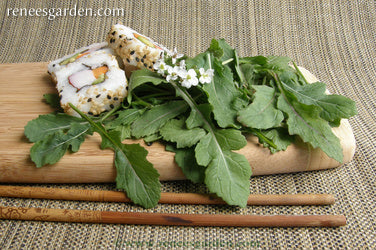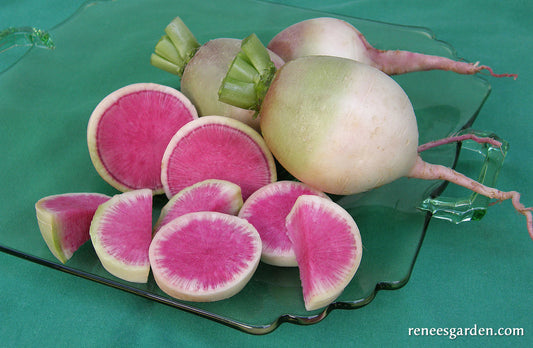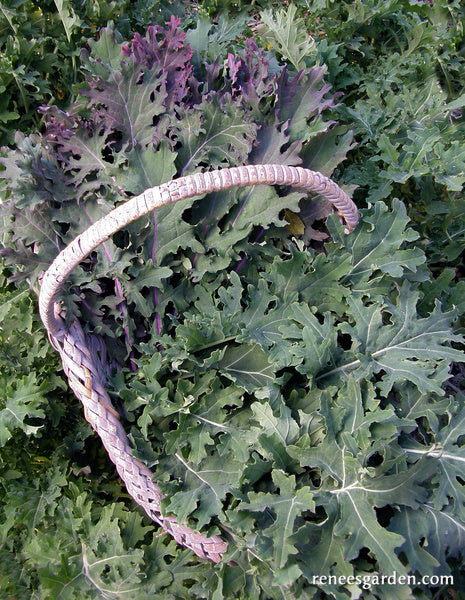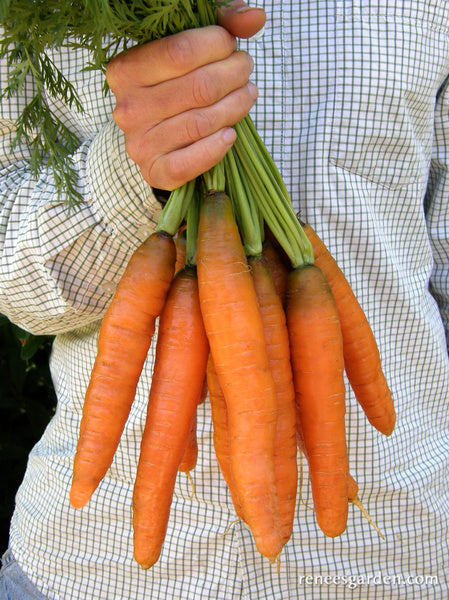Cool Weather Vegetables and Herbs
Easy to grow, highly nutritious and great tasting, these favorite early spring vegetables love cool weather and are the first varieties you can direct sow in the garden. If you live in colder climates, sow as soon as the danger of frost has passed. Fast-growing for earliest harvests, you'll find complete planting instructions on every packet and on our website.
-
Kitchen Herbs Sweet Curly Parsley
TO PLANT DIRECTLY IN THE GARDEN
In spring when weather is settled but still cool, sow seeds 1 to 2 inches apart into well-worked fertile soil in full sun and cover 1/4 inch deep. If climate is very hot, plant in a spot with morning sun and afternoon shade. Parsley germinates unevenly over several weeks; be patient and keep seed bed evenly moist.
TO START EARLY INDOORS
Sow parsley seeds in early spring in a container of seed starting mix. Cover 1/4 inch deep, and keep container moist but not soggy until seedlings emerge. Provide a good light source. Feed seedlings frequently until ready to transplant when about 2 inches tall after acclimating to outdoor conditions.
THIN OR TRANSPLANT
Space 3 to 4 inches apart when seedlings have several sets of leaves.
GROWING NOTES
Parsley needs rich moist soil and ample spacing for lush harvests. Thin early and keep well weeded and watered. Begin to harvest sparingly once plants have 8 to 10 leaves. Fertilize monthly with a high nitrogen source for best leafy growth.Regular price $2.99Sale price $2.99Unit price / per -
Farmers Market Lettuce Blend Sweet Greens & Reds
START SEEDS OUTDOORS
In cool early spring weather, sow seeds in finely worked soil in full sun. Shake seeds from the palm of your hand, broadcasting them about 1/2 inch apart over the entire seedbed or in wide rows, and cover lightly and evenly with 1/4 inch of fine soil. Firm soil gently and water with a fine spray. Keep seedbed evenly moist. Make small successive sowings until summer weather turns hot for a constant supply. Plant again in late summer for fall harvesting.
GROWING NOTES
Mixed lettuces thrive in mild weather with consistent moisture. To extend the sowing season into hot weather, sow in light shade or erect a canopy of loosely woven shade cloth over the bed. Birds are often attracted to tender young seedlings, so protect them if necessary.
HARVEST AND USE
To harvest by the “cut and come again” method, wait until plants are 4 or 5 inches tall. Cut as much lettuce as you need, using scissors to shear off a patch of leaves 1 to 2 inches above the soil level. Water well and fertilize lightly and plants will regrow for several more cuttings. Dress with a simple vinaigrette to enjoy the sweet flavor and juicy texture of these delicate young leaves at their best.
Regular price $2.99Sale price $2.99Unit price / per -
Roasting Beets Sweet Merlin
START SEEDS OUTDOORS
In early spring, when danger of hard frost is over, sow seeds in well-worked, fertile soil in full sun. Sow seeds 1 inch apart and 1/2 inch deep in rows 8 inches apart, or broadcast thinly for bed planting. Firm soil well over these irregularly shaped seeds to ensure good germination.
If first sowing germinates unevenly, plant more seed as seedlings will catch up fast. Carefully thin young seedlings to 3-4 inches apart so individual beets have room to size up.
GROWING NOTES
For best quality beets, sow seeds before midsummer heat and again in early fall. Keep soil evenly moist throughout the growing season. Be sure to thin beet seedlings carefully several times as they grow best when given enough room.
HAREVST AND USE
Harvest mature beets when at least several inches in diameter or size them up even bigger. Cut off the tops and reserve. Wash the roots, wrap in foil and then roast to perfection in a preheated 350° F oven until tender when pierced—takes at least an hour, depending on your oven. Cool, peel, slice and enjoy with butter and chopped fresh herbs. Or simply peel, slice and add roasted beets to salads. Steam the tender beet tops for tasty and nutritious greens.
Regular price $4.39Sale price $4.39Unit price / per -
Container Lettuce Sweetie Baby Romaine
START SEEDS OUTDOORS
In cool spring weather, start seeds in full sun. Sow seeds 1/4 inch deep and 1 inch apart in fertile, well-drained soil mix. After the seedlings germinate and begin to grow, it’s important to thin the young plants so they have room to mature into heads. Thin seedlings when a few inches tall to a final spacing of 5 inches apart so they have room to mature to full heads (extra seedlings will transplant easily to grow elsewhere). Plan on 7 to 10 full heads in a 16-18 inch pot or an 18-24 inch window box. Plan on 3 full heads in an 8 inch pot.
GROWING NOTES
Lettuce thrives in cool conditions. Be sure to thin properly and keep evenly moist for sweet tasting, full heads. For a constant supply, make several sowings a few weeks apart until summer weather turns hot.
Plant again in late summer for fall harvest. In hot weather, give lettuce some afternoon shade and check water daily. Feed with liquid fertilizer every 2 weeks.
Try setting seedlings around the edges of a big pot holding a young tomato or pepper plant. Harvest the lettuce as the bigger plant grows to need the space.
HARVEST AND USE
Savor young lettuce thinnings in your first spring salads. Then harvest plants by cutting mature heads when they feel firm and well-filled. Pull over-mature plants if they begin to elongate (“bolt”) in hot weather, as leaves turn bitter at this stage.
Regular price $3.39Sale price $3.39Unit price / per -
Bonus Pack Tendersweet Carrot
One of the sweetest bunching carrots you can grow. Long slender carrots grow to 8-9 inches. Deep orange roots are crisp and sweet and almost coreless. Harvest in 72-80 days.Regular price $7.89Sale price $7.89Unit price / per -
Heirloom Beets Traditional Chioggia
START SEEDS DIRECTLY OUTDOORS
In early spring, when danger of hard frost is over, sow seeds in well-worked, fertile soil in full sun. Sow seeds 1 inch apart and 1/2 inch deep in rows 8-10 inches apart, or broadcast thinly for bed planting. Firming soil well over these irregularly shaped seeds will ensure best germination. If first sowing comes up unevenly, sow more seeds as seedlings will catch up fast. When large enough to handle, carefully thin seedlings to 3 to 4 inches apart so growing beets have room to size up.
GROWING NOTES
For best quality, tender roots, sow seeds before midsummer heat and again in late summer to early fall — in cold climates, allow at least 10 weeks before fall frosts. Keep soil evenly moist throughout the season. Be sure to thin seedlings several times when plants are small, as beets grow best if given enough room.
HARVEST AND USE
After thinning seedlings, use tender young tops for nutritious, flavorful steamed greens. Harvest baby beets at 1 to 2 inches in diameter, or let roots grow as large as desired. Garden fresh beets cook quickly. They are delicious steamed, boiled or baked whole in their skins like potatoes, then peeled for concentrated flavor. Chioggia beets are especially mild and sweet tasting.
Regular price $4.89Sale price $4.89Unit price / per -
Heirloom Sweet Parsley Triple Curled
BIENNIAL, GROWN AS ANNUAL
Spring/summer/fall harvest
Frost hardyTO PLANT DIRECTLY IN THE GARDEN
In spring when weather is settled but still cool, sow seeds 1 to 2 inches apart into well-worked fertile soil in full sun and cover 1/4 inch deep. If climate is very hot, plant in a spot with morning sun and afternoon shade. Parsley germinates unevenly over several weeks; be patient and keep moist.
TO START EARLY INDOORS
Sow parsley seeds in early spring in a container of seed starting mix. Cover 1/4 inch deep, and keep container moist but not soggy until seedlings emerge. Provide a good light source. Feed seedlings frequently until ready to transplant when about 2 inches tall after acclimating to outdoor conditions.
THIN OR TRANSPLANT
Space 4 to 6 inches apart when seedlings have several sets of leaves. Feed monthly for best results.
GROWING NOTES
Parsley needs rich moist soil and ample spacing for lush harvests. Thin early and keep well weeded and watered. Begin to harvest sparingly once plants have 8 to 10 leaves. Fertilize monthly with a high nitrogen source for best leafy growth.Regular price $4.89Sale price $4.89Unit price / per -
Portuguese Kale Tronchuda Beira
TO START DIRECTLY IN THE GARDEN
As soon as ground can be worked in spring, prepare a well-drained, fertile garden bed in full sun. Sow groups of 2 to 3 seeds, each group 12 to 18 inches apart. Cover 1/4 deep and keep soil evenly moist to ensure good germination. Thin to one seedling per group when several inches tall. Sow again in mid to late summer for another cold-hardy crop.
TO START INDOORS
Sow seeds in a container of seed starting mix 2 inches apart and cover 1/4 inch deep. Keep moist and provide a strong light source until seedlings are 3 to 4 inches tall, then plant outdoors. Space 12 to 18 inches apart.
GROWING NOTES
Kale can be sown in spring as early as the ground can be worked. A second mid to late summer-sown crop will yield through fall and winter except in the coldest climates. Frost actually enhances kale leaves’ color, flavor and sweetness. Mulch to retain moisture in summer and before the ground freezes to protect the roots of fall crops.
HARVEST AND USE
Begin harvesting large individual outer leaves when plants have 6 to 8 big leaves. Enjoy sautéed, stirfried, braised or added to soups and stews. Portuguese kale pairs well with olive oil, garlic and lemon juice (reneesgarden.com/portuguese-kale-soup). Pull and discard once plants begin to bloom as the leaves of flowering stalks get tough and bitter.
Regular price $3.99Sale price $3.99Unit price / per -
Arugula True Italian
EASIEST TO START OUTDOORS
In early spring, sow seeds directly into well-worked garden soil 1 to 2 inches apart in rows 10 inches apart in full sun. Cover 1/4 inch deep and firm soil over seeds. Keep seed bed evenly moist until seedlings emerge in 7 to 14 days. Make new sowings every 2 weeks until early summer for a constant supply of fresh non-bitter leaves. Young leaves are ready to begin harvesting in 3 to 4 weeks. In hot summer areas, wait to sow again in late summer for fall use, as summer heat makes leaves very pungent.THIN OR TRANSPLANT
Arugula grows so quickly we recommend sowing in place rather than transplanting. Thin seedlings 2 to 3 inches apart when plants are large enough to handle.GROWING NOTES
Begin harvesting by thinning little seedlings to use in salads when they are several inches tall, leaving remaining seedlings to mature 2 to 3 inches apart. Either pick individual leaves when they are 3 to 4 inches long, or snip leaves about 1 inch above the crown and let plants regrow for more harvests.Regular price $4.89Sale price $4.89Unit price / per -
Heirloom Italian Kale Tuscan Baby Leaf
BEST TO START DIRECTLY OUTDOORS
Beginning in early spring, sow seeds in finely worked soil in full sun. Shake seeds loosely from your hand, broadcasting about 1 inch apart over the entire seedbed or in wide rows, and cover lightly and evenly with 1/4 inch of fine soil. Firm soil gently and water in with a fine spray, then keep seedbed evenly moist. Make successive sowings every 3 weeks until summer weather turns really hot for a constant supply. Plant again in late summer for fall harvesting.
GROWING NOTES
For best flavor, kale needs consistent moisture and mild weather conditions. Birds love tender young kale seedlings, so protect them as necessary with netting or floating row covers. This attractive edible will also grow well in pots at least 18 to 20 inches across to snip as needed for salads or stir-fry.
HARVEST AND USE
To harvest by the “cut and come again” method: when plants are 4 to 5 inches tall, cut as much as you need, by using scissors to shear off leaves 1 to 2 inches above the soil level. Water well and fertilize lightly and plants will regrow for several more cuttings. These tasty and highly nutritious leaves are delicious used as fresh salads, especially with a handful of chopped nuts and fruit like apples or pears. Or stir-fry very quickly for healthy quick greens.
Regular price $4.39Sale price $4.39Unit price / per -
Gourmet Herbs Wasabi Arugula
ANNUAL
Spring/summer/fall harvest
Frost hardyEASIEST TO START OUTDOORS
Plant in spring (or late summer for a fall crop) directly into the garden in well-worked soil in full sun, or a spot that receives partial afternoon shade. Sow 1 inch apart and barely cover.
Keep the seed bed evenly moist until seedlings emerge in 10 to 12 days. Begin harvesting individual young leaves in 4 to 5 weeks. In hot summer areas, wait to sow again in late summer for fall use, as extreme heat makes leaves extra pungent.
GROWING NOTES
Harvest early by thinning seedlings to use in salads when they are several inches tall, leaving remaining seedlings to grow to maturity 4 to 5 inches apart. Pick individual leaves when they are 3 to 4 inches long, or snip each whole leafy rosette about 1 inch above the crown and let plants regrow for extended harvests. This long-lasting arugula stays leafy so you can use it all season. Pick the little edible flower stalks of dainty white blossoms off the plants to keep seed heads from forming as this diminishes leaf quality.Regular price $3.69Sale price $3.69Unit price / per -
Heirloom Radishes Watermelon
START SEEDS DIRECTLY OUTDOORS
Plant watermelon radishes at midsummer for fall harvest only. They size up and get sweeter as temperatures drop at the end of the growing season. Sow seeds in well-worked, fertile soil in full sun. Space seeds 1 inch apart, in rows 6 inches apart. Cover 1/2 inch deep. Keep soil evenly moist and well weeded. If the first sowing comes up unevenly, replant right away.
GROWING NOTES
Thin seedlings early to stand 3 inches apart; Watermelon radishes get big, up to three or even four inches in diameter and need room to size up. These Asian-style radishes grow more slowly than spring radishes, so be sure they have consistent moisture for best quality and flavor. Protect with a barrier of floating row cover if marauding birds or insect pests are a problem.
HARVEST AND USE
For best quality, harvest watermelon radishes promptly when sized up 2 to 4 inches in diameter. Note: Interior flesh becomes rosy red when roots are fully mature. Their flavor will be milder and sweeter harvested in cool fall weather. These roots will keep their eating quality for weeks in your refrigerator. For a beautiful and colorful salad, make a plate of very thinly sliced watermelon radishes sprinkled with oil and rice wine vinegar or fresh lemon juice and chopped scallions.Regular price $3.99Sale price $3.99Unit price / per -
Heirloom Russian Kale Wild Garden Frills
TO START DIRECTLY IN THE GARDEN
As soon as ground can be worked in spring, prepare a well-drained, fertile garden bed in full sun. Sow seeds 2 inches apart in rows 12 to 18 inches apart. Cover 1/2 inch deep and keep soil evenly moist to ensure good germination. Sow again in late summer for another cold-hardy crop.
TO START INDOORS
Sow seeds in a container of seed starting mix 2 inches apart and cover 1/2 inch deep. Keep moist and provide a strong light source until seedlings are 3 to 4 inches tall then plant outdoors. Space 10 to 12 inches apart so plants have room to mature.
GROWING NOTES
Kale tastes best in cool weather so sow spring crops early. If sown in late summer, kale will yield through fall and winter except in the coldest climates. Frost actually enhances kale leaves’ color, flavor and sweetness. Mulch to retain moisture in summer and before the ground freezes to protect the roots of fall crops.
HARVEST AND USE
Begin harvesting outer leaves when plants have 6 to 8 leaves. Vitamin-rich kale is delicious in hearty winter soups, stews and sautés; or braise the beautiful leaves with garlic and olive oil in traditional Mediterranean style. Pull and discard once plants begin to bloom since the leaves of flowering stalks get tough and bitter.
Regular price $4.89Sale price $4.89Unit price / per -
Signature Salads Wine Country Mesclun
START SEEDS OUTDOORS
In early spring, sow seeds in finely worked soil in full sun. Shake seeds from the palm of your hand, broadcasting them about a half inch apart over the entire seedbed or in wide rows, and cover lightly and evenly with 1/4 inch of fine soil. Firm soil gently and water in with a fine spray. Keep seed bed evenly moist. Make small successive sowings until summer weather turns hot for a constant supply. Plant again in late summer for ample fall harvesting.
GROWING NOTES
This mesclun mix thrives in mild weather with consistent moisture. To extend the sowing season into hot weather, sow in light shade or erect a canopy of loosely woven shade cloth over the seedbed. Birds are often attracted to tender young seedlings so protect them if necessary.
HARVEST AND USE
To harvest by the “cut and come again” method, wait until plants are 4 or 5 inches tall. Cut as much as you need, using scissors to shear off a patch of leaves 1 to 2 inches above the soil level. Water well and fertilize lightly and plants will regrow for several more cuttings. Dress with a simple vinaigrette to set off the wonderful colors, diverse fresh flavors and delicate textures of this delicious salad mix.
Regular price $3.39Sale price $3.39Unit price / per -
Nantes Carrots Yaya
START SEEDS OUTDOORS
In spring once danger of hard frost is past, sow seeds in full sun in finely worked, fertile soil. Sow 1/4 inch deep and 1/2 inch apart in rows 8 inches apart, or broadcast thinly in beds and cover lightly. Keep seedbed evenly moist as carrots can be slow to germinate, emerging over 10 to 20 days. If first sowing comes up unevenly, replant right away as seedlings catch up quickly. Be sure to thin young carrots several times so seedlings are about 2 inches apart and have room to size up.
GROWING NOTES
Carrots like well-worked soil and need consistent moisture to grow well. If your soil tends to dry out, cover seedbed with floating row cover or burlap to help retain moisture during the germination period and water right through it. Keep carrots well watered and thinned. For a late season crop, sow again 3 months before first expected frost.
HARVEST AND USE
Let young carrots size up and color fully to orange before harvesting for best flavor. Sauté or steam just until tender crisp and serve with a squeeze of fresh lemon or lime juice, sweet butter and fresh dill; or try buttered and glazed with a little maple syrup or honey.
Regular price $4.89Sale price $4.89Unit price / per -
‘Hamburg Rooted’ Parsley
This traditional heirloom vegetable is grown for its 8-to-10 inch roots that are shaped like parsnips or carrots. Hamburg rooted parsley adds a wonderful mellow parsley flavor to soups and stews.Regular price $1.99Sale price $1.99Unit price / per

